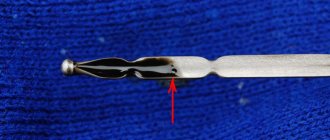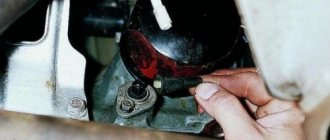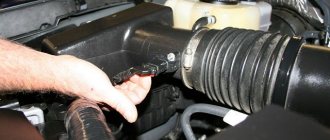The engine lubrication mechanism works to supply automobile oil to the moving parts of the power unit under pressure created by the oil pump. If for various reasons a drop in engine oil pressure occurs, the lubricant will not be able to reach all parts of the unit, which can lead to its breakdown. Therefore, to constantly monitor the level of lubricant pressure, a sensor (light) is located on the dashboard of the car, which, in the event of a malfunction, sends a signal to the driver.
If the oil pressure light comes on while the engine is warm, the driver should quickly stop the car and take all measures to eliminate the problem.
What happens when the oil pressure light comes on on a warm engine?
If problems arise with the pressure level, the engine begins to experience the following problems:
- lack of lubricant;
- wear of moving parts increases;
- the heating of the engine as a whole increases;
- engine cleaning from soot and various deposits is reduced;
- malfunction with subsequent breakdown of bearings;
- Noise in the engine housing increases.
All of the problems listed above ultimately lead to jamming and engine failure.
Special malfunctions of VAZ engines
These problems are common to almost all types of engines used in cars, including domestic ones.
But there are also specific faults that occur only on certain cars.
On classic models VAZ-2106, 2107, the pump is driven from the timing chain via a drive gear and a drive roller.
A common problem in the malfunction of the lubrication system is wear of the gear sector on the gear or shaft. Replacing these elements allows you to get rid of problems.
As for modern cars, from the VAZ-2108 to the VAZ-2115, they have a direct pump drive, from the crankshaft gear.
The absence of intermediate elements in the design has increased the reliability of the drive, so the problems that arise in the engines of classic VAZs do not occur in modern cars.
Diagnosing oil pressure problems
Checking the engine oil level . The cause of the problem may be a small amount of lubricant in the unit.
The reason for the decrease in level may be:
- through damage to the oil pan;
- increased engine consumption due to severe wear;
- increased oil consumption due to waste;
- wear or improper operation of the oil pump.
Having such problems, you need to immediately tow the car to the nearest service station to eliminate the above problems.
Simply adding oil to the required level will not solve the problem. Replacement with lubricant of optimal viscosity . Each brand of car has its own brand of lubricant that must be used during its operation. For example, using 0W20 oil instead of 5W40 leads to severe dilution of the lubricant, since the lubricant used does not comply with the car manufacturer’s recommendations in the manual. This situation can lead to leaks of engine gaskets and seals, which is guaranteed to lead to a decrease in the engine oil level and a drop in its pressure. To avoid getting into such a difficult situation, you need to carefully select the viscosity indicator and other main indicators.
Good to know: Is it possible to add oil to an engine of another brand?
Timely replacement according to the kilometers traveled. It is important to remember that oil may simply lose its protective properties after a certain period of time. It is recommended to replace it after 10-14 thousand km.
Good to know: When should you change the engine oil based on mileage or once a year | How long does it take to change the engine oil
Undesirable mixing with antifreeze. Such troubles can arise from cracks in the cylinder block or from a breakdown of the cylinder head gasket. When antifreeze is mixed with oil, the chemical properties of lubricants change and deteriorate. The first sign of such problems is the presence of an emulsion on the surface of the oil dipstick.
Fuel getting into the engine oil. This problem can arise when the ignition and subsequent combustion of fuel in the engine cylinder is disrupted. As a result, fuel gets into the oil, which greatly dilutes it and leads to a drop in lubricant pressure.
Excessive abuse of various additives. Adding various additives to the oil can also lead to a loss of lubricant quality and ultimately lead to problems.
Good to know: Which motor oil is not counterfeited in Russia, list of the best
Wear of various engine parts. This situation may be caused by an increase in gaps between parts, resulting in a drop in engine pressure and excessive consumption of lubricant. Such problems need to be solved only with the help of a major overhaul of the unit. Various additives will only alleviate the situation temporarily.
Oil receiver filter clogged. If a sufficient amount of lubricant does not pass through this element, the engine will begin to feel a lack of lubricant with all the ensuing negative consequences. The filter may become clogged due to the fact that various types of contaminants have accumulated on the walls of the pan. To solve this problem, you need to clean the oil receiver filter from dirt, thereby solving the problem of engine oil passing through it.
Timely replacement of the oil filter. If the filter is not replaced with a new one in time, it may become clogged and this may ultimately cause a drop in pressure levels. In addition to clogging, the oil filter may be of poor quality, which will negatively affect the operation of the engine lubrication system.
Good to know: Do I need to fill the filter with oil when changing the oil?
Irregular operation of the pressure relief valve. The valve, by its design, remains closed until the pressure exceeds the required norm. But if the valve sometimes sticks in the open position and then it is impossible to obtain the required pressure.
Oil pump failure. If this element breaks down, it must be quickly replaced or repaired. After all, without proper and constant operation of the oil pump, it is impossible to ensure uninterrupted and high-quality lubrication of all rubbing engine parts.
Verdict
The emergency oil pressure lamp lights up in the following cases:
- Immediately after replacing the lubricant, this is not a malfunction (then it should go out).
- There is not enough oil in the crankcase.
- I shorted the wire that goes to the sensor to ground.
- The oil system sensor or filter is clogged.
- The filter element is poorly tightened or made using counterfeit technology.
- The sensor for measuring the lubricant pressure in the unit is faulty.
- Problems with the condition of the engine lubrication system.
To make it easier for drivers to monitor the operation of the power plant, the engine systems are equipped with control sensors. Their task is to monitor the operation of the system and, if a malfunction occurs, immediately alert the driver about it.
Control sensors are connected to warning lights and instruments installed on the dashboard in the cabin. This allows the driver to immediately notice a malfunction.
One of the most important warning lights, the lighting of which should alarm any driver, is oil pressure.
Before starting the engine, after turning the ignition key, this indicator always lights up, indicating that there is no pressure in the system. But after starting the engine, it should go out and not light up again until the power unit is stopped.
The operation of the control sensor is quite simple - while there is no pressure in the system, it closes the contacts, causing the lamp to light.
After starting the engine and increasing the pressure to a certain level, the contacts open and the lamp goes out. In a fully functional engine, it goes out no later than 1-2 seconds after starting.
The principle of operation of the lubrication system of a car engine
Many passenger cars have a combined lubrication system. Under pressure, oil moves into the main line from the crankcase through the receiver and filter. Further, it is supplied through the channels to the main and connecting rod bearings of the crankshaft, camshaft supports, and also to the piston pins. The lubrication system has control valves:
- pressure-reducing, triggered by excess pressure. Excess oil is dumped into the inlet;
- When the filter is clogged, the bypass valve is activated, supplying unrefined oil.
Other procedures
Since there are many reasons why the car oil pressure light comes on, other actions may be required to resolve the problem:
- Oil pump malfunction. If a problem is detected with the device, remove it and try to repair it. If repair is not possible, then the oil pump needs to be completely replaced.
- Oily fluid is leaking from the system. If you regularly notice how the engine “eats” oil even at idle, you need to find the place where the lubricant is leaking. Any car has a “normal” consumption, which is written about in the documents. If this indicator is overestimated, diagnostic procedures are required. It is necessary to check the parts of the fuel complex and the condition of the cylinder head oil seal. Typically, a leak appears from under the sealing elements or seals.
- Blown head gasket. If you find a similar problem that causes the oil pressure lamp to light up, carry out repairs as soon as possible. Driving with a deformed cylinder head is unsafe for the engine. There is a possibility that the engine will simply turn off during operation of the machine.
Tips and tricks
Please note that if no leaks are visible, and the oil level and its condition are normal, then before starting complex operations to disassemble the engine, experts recommend accurately measuring the oil pressure in the engine at the initial stage.
Quite often it happens that there is actually nothing wrong with the pressure, and the faults that lead to the warning light coming on are directly related to the wiring and the oil pressure sensor.
The contacts may oxidize over time, and the sensor may also fail. It is quite obvious that these elements also need to be checked first and foremost as part of diagnostic procedures.
What does the lamp indicate?
The indicator light on the dashboard reacts strictly to engine oil pressure. Due to the level being reduced within reasonable limits, the signal will not appear on the panel. The exception is the loss of 2/3 of the lubricant when the oil intake of the pump begins to pick up air and crankcase gases. Then the pressure in the lubricating channels will inevitably drop, to which the sensor will react and the light will light up.
The oil receiver is specially installed at the bottom of the pan so that the system operates when there is a lack of lubrication
The circuit, signaling problems with lubrication of the power unit, consists of parts that also periodically break. So a flashing lamp does not always mean fatal engine failure. But if it lights up on your car, then you need to act like this:
- Stop moving.
- Turn off the engine.
- Check the lubricant level and, if necessary, add up to normal. The lubricant level in the car engine is checked with a special dipstick
- Topping up did not work - transport the car to the garage or to a car service using a tow truck or in tow.
- If the indicator light is intermittent (flashing), then move to the repair site under your own power at low speed. Monitor the coolant temperature gauge and pressure light: when it stops flashing and lights up, immediately turn off the engine.
In your garage, you can find the cause of the alarm if you follow the steps below.










